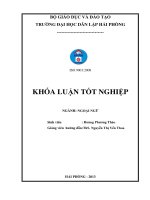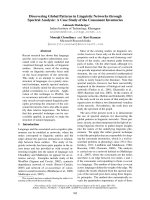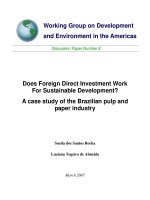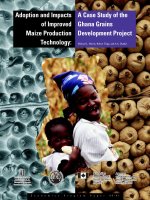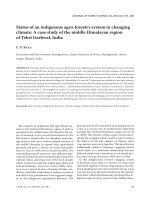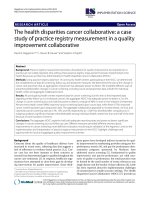Industrial design strategies for sustainable development a case study of the packaging industry in singapore
Bạn đang xem bản rút gọn của tài liệu. Xem và tải ngay bản đầy đủ của tài liệu tại đây (4.03 MB, 136 trang )
INDUSTRIAL DESIGN STRATEGIES FOR
SUSTAINABLE DEVELOPMENT
A CASE STUDY OF THE PACKAGING INDUSTRY IN SINGAPORE
FLAVIA TENUTA DE FREITAS
(B.A. Product Design, UEMG)
A THESIS SUBMITTED FOR THE DEGREE OF MASTER OF ARTS
(INDUSTRIAL DESIGN)
DIVISION OF INDUSTRIAL DESIGN
NATIONAL UNIVERSITY OF SINGAPORE
2012
ABSTRACT
This study seeks to investigate current design tools being used in the
packaging industry of Singapore during the product development stages.
Furthermore, this research aims to encourage the creation of more sustainable
products as well as to contribute to a more practical approach for sustainable
design, bringing benefits to business and to other parties involved. Therefore,
this study shows some of the existing Industrial Design strategies for
sustainable development taking place in Singapore by investigating into
representative cases from the packaging industry.
On account of the growing amount of waste in Singapore and its limited land,
the government has developed a special plan for solid waste management,
which includes special measures regarding the reduction of domestic waste. In
Singapore, about one third of total domestic waste in 2009 was packaging
waste (SPA, 2010). Therefore, several of these initiatives are directly related to
the packaging industry which allowed me to observe and analyse the Industrial
Design responses to some of these programs in its early stages.
The outcomes of this study comprise a critical analysis of the design tools and
methods being currently used by the packaging industry in Singapore towards
sustainable development; an analysis of some of the products developed by
these companies within the given context; a profile of the consumers of the
sector studied; as well as a profile of the packaging industry of Singapore
regarding sustainable development initiatives with respect to local and global
scenarios.
i
ACKNOWLEDGEMENTS
I would like to express my gratitude to my supervisor, Dr. Christian G.
Boucharenc,
whose
expertise,
understanding,
and
patience,
added
considerably to my graduate experience. I would also like to thank Dr. Yen
Ching Chuan for all the assistance he provided during the development of this
research project. I would also like to thank Dr. Carlos Montana for his friendship
and guidance.
A very special thanks goes out to Daniel, life partner and best friend, for his
everyday patience, kindness and support. I would also like to thank my family
for all the love and encouragement they have always given me.
In conclusion, I would like to express my gratitude to the financial assistance of
the National University of Singapore. This research would not have been
possible without the NUS Graduate Research Scholarship.
ii
CONTENTS
ABSTRACT ..................................................................................................... i
ACKNOWLEDGEMENTS ................................................................................ii
CONTENTS .................................................................................................... iii
LIST OF FIGURES .........................................................................................vi
LIST OF TABLES .......................................................................................... vii
1 AN INTRODUCTION TO THE THESIS ......................................................... 1
1.1 Personal motivation .................................................................................. 1
1.2 Introduction ............................................................................................... 2
1.3 The research structure.............................................................................. 5
1.3.1 1st Phase ............................................................................................ 7
1.3.2 2nd Phase ........................................................................................... 7
2 THE RESEARCH STEP BY STEP................................................................ 9
2.1 The topic definition ................................................................................... 9
2.2 1st phase ................................................................................................ 10
2.2.1 Research question ........................................................................... 10
2.2.2 Hypotheses ...................................................................................... 12
2.2.3 Objectives ........................................................................................ 12
2.2.4 Methodology .................................................................................... 13
2.2.5 Case Study Design .......................................................................... 14
2.2.6 Expected Outcomes ......................................................................... 16
iii
3 THE LITERATURE REVIEW......................................................................... 17
3.1 Industrial Design and Sustainable development ..................................... 17
3.1.1 Sustainable development ................................................................. 17
3.1.2 Design .............................................................................................. 19
3.1.3 Industrial Design .............................................................................. 20
3.1.4 Overview of Systems Thinking ......................................................... 22
3.1.5 Eco-Design ...................................................................................... 27
3.1.6 Sustainable Design .......................................................................... 29
3.1.7 LCA .................................................................................................. 31
3.2 Singapore and sustainable development ................................................ 32
3.2.1 Singapore and its sustainable development Program ...................... 33
3.2.2 Solid waste management and limited land ....................................... 35
3.2.3 The Singapore Packaging Agreement ............................................. 35
4 RESEARCH SCOPE AND LIMITATIONS ..................................................... 38
5 THE CASE STUDY - Data Collection Protocol.............................................. 41
5.1 Companies’ Interview ............................................................................. 41
5. 2 Checklist ................................................................................................ 42
5. 3 Survey ................................................................................................... 44
6 THE CASE STUDY - Findings ...................................................................... 47
6.1 Interview ................................................................................................. 47
6.1.1 LC01 ................................................................................................ 48
iv
6.1.2 LC02 ................................................................................................ 50
6.1.3 LC03 ................................................................................................ 53
6.1.4 MnC01 ............................................................................................. 57
6.1.5 MnC02 ............................................................................................. 60
6.1.6 MnC03 ............................................................................................. 63
6.2 CHECKLIST ........................................................................................... 66
6.2.1 The companies’ strategies and the sustainable development aspects
.................................................................................................................. 66
6.2.2 The companies’ strategies and the life cycle phases ....................... 71
6.3 Survey .................................................................................................... 81
6.3.1 CHOOSE. by Olive Ventures ........................................................... 90
6.3.2 Simply Living .................................................................................... 91
7 ANALYSIS AND DISCUSSION OF THE RESEARCH FINDINGS ................ 93
7.1 The companies’ understanding of ‘Sustainable development’ and how it
may influence their design strategies preferences........................................ 93
7.2 The relevance of the Singapore Packaging Agreement ....................... 102
7.3 The importance of systemic thinking and how a Life cycle approach could
make a difference ....................................................................................... 109
7.4 The consumers and the environmental awareness in Singapore. ........ 111
8 CONCLUSIONS AND DIRECTIONS FOR FUTURE RESEARCH ............. 113
8.1 The need to embrace a holistic approach ............................................. 113
8.2 Future Research ................................................................................... 115
v
BIBLIOGRAPHY ............................................................................................ 116
Appendix 1 - Companies’ interview questionnaire ...................................... 125
Appendix 2 - Survey ................................................................................... 128
LIST OF FIGURES
Figure 1. The research structure ........................................................................ 6
Figure 2. The research structure - Phase 1 ...................................................... 10
Figure 3. Basic types of design for case studies (Yin 1994)............................. 14
Figure 4. Possible approaches to the case study. Adapted fromYin (1994) ..... 15
Figure 5. General product + packaging Life-cycle, adapted from Heller and
Keoleian (2003). ............................................................................................... 32
Figure 6. Singapore localization ....................................................................... 33
Figure 7. Case study scope product Life-cycle. Adapted from Heller and
Keoleian (2003) ................................................................................................ 40
Figure 8. Checklist analysis 1 – Economic, Environmental and Socio-cultural
Aspects ............................................................................................................ 67
Figure 9. Checklist analysis 2 - Environmental Aspects ................................... 69
Figure 10. Checklist analysis 3 - Socio-cultural aspects .................................. 70
Figure 11. Illustration of the Checklist Environmental Aspects ......................... 75
Figure 12. Illustration of the Checklist Socio-cultural Aspects ......................... 78
Figure 13. Illustration of the data collected from the survey 1 .......................... 82
Figure 14. Illustration of the data collected from the survey 2 .......................... 85
vi
Figure 15. Illustration of the data collected from the survey 3 .......................... 88
Figure 16. Answers to the first question of the companies’ interview ............... 94
Figure 17. Illustration of the checklist results.................................................. 100
Figure 18. companies’ classification of products’ sustainability ..................... 101
Figure 19. Answers to question 11 of the companies’ interview ..................... 105
Figure 20. Answers to question 12(a) of the companies’ interview ................ 106
Figure 21. Answers to question 12(c) of the companies’ interview................. 107
LIST OF TABLES
Table 1. Percentage of companies that resorted to each of the strategies
studied I ...........................................................................................…………...72
Table 2. Percentage of companies that resorted to each of the strategies
studied II...........................................................................................…………...97
vii
1 AN INTRODUCTION TO THE THESIS
“Design is the conscious effort to impose a meaningful order.” Papanek, V.
(1985)
1.1 Personal motivation
The environmental impact of human activities on the planet earth is directly
related to three main factors: the number of people on the planet, the amount of
resources used by each person and the environmental pollution and
degradation caused by the use of such resources (Corson, 1994).
From this perspective, it is not difficult to see that most of the attempts and
alternatives proposed worldwide to deal with this problem usually deal with
second mentioned factor. Recycling and reuse of products and materials and
environmental awareness educational programs are examples of alternatives
proposed to lessen the growing amount of resources consumed by each person
on the planet.
It is undeniable that a significant reduction of resources and materials used
would lessen the harm to the environment. Nevertheless, such actions are
efficient only at attenuating the problem. The third mentioned factor has been
identified as the real cause of the negative environmental impact of human
activities on the planet (McDough and Braunghart, 2002). Therefore, the
problem of environmental pollution and degradation caused by the use of such
1
resources can only be solved once I change the way I use the resources to
generate energy and make products to a totally clean, non pollutant alternative.
Moreover, as discussed by McDough and Braunghart (2002), if such an
alternative is ever developed and put into practice; as to say, if new materials
and technologies are developed in accordance with the environment or even as
an integrated part of it, then the growth of the population or of the use of
resources may no longer be a problem. But how could such an alternative be
developed? Would there be a way of making clean products and clean energy?
In that case, would there be a sustainable way of doing so? And then, what
would be the role of Industrial Design within this new context?
As a first step I believe it is important to completely understand the actual
situation, so as to be able to start proposing better alternatives. Sustainable
development and Industrial Design are the main focus of this research project.
In order to facilitate the analysis of such broad concepts, this study proposes
the investigation of their interaction within a more specific context, namely the
packaging industry in Singapore.
1.2 Introduction
The economy of the Asian developing countries has been described as the
largest economy in the developing world (Chiu & Yong, 2004). The Asian
economy has experienced the most rapid increase in its history in the last two
decades, bringing undeniable short term benefits to these countries. However,
such rapid growth has also brought several environmental challenges which
include sand storms, acid rain, floods, forest depletion, solid waste pollution,
2
among others. As a possible solution to these problems, several authors
including Chiu and Yong (2004) have suggested the need for a sustainable
development strategy.
The more I analyse the problems of the modern society, the more I see that
most of them are interconnected, mutually dependent, and cannot be treated
separately. Most of the attempts to define ‘sustainable development’ require
that I understand the earth as a system that interconnects social and economic
development and environmental protection over space and time. In developed
countries, the changes required are mostly limited to integrating environmental
concerns into peoples’ lives as well as into political and economic decisions.
However, in developing countries, social, economic and environmental issues
tend to need more substantial considerations (Mitchell, 1994).
In the current scenario, where everything must be planned and projected, the
Design comes as a powerful tool allowing people to mould their objects, their
services, their environment and consequently the society itself (Papanek,
1985).
The republic of Singapore is a country located on the southern part of the Malay
Peninsula in Southeast Asia. An island of 660 Km2, it brigades a population of
4.7 million people. Over the past 40 years the government has implemented
and updated different plans for the continuous development and economic
growth of the country. As a result, Singapore has been described as the most
successful economy in Southeast Asia, ahead of South Korea, Hong Kong and
Taiwan (Lim, 1983). However, Singapore is still on its early stages of
3
development regarding sustainability issues, compared to some European
countries (Chiu and Yong, 2004).
As relatively small country, Singapore continually faces the problem of limited
land, especially in terms of solid waste management. Regarding this matter, the
Singaporean government has launched a series of programs, which are
assessed in this study with respect to the Industrial Design context.
In Singapore, about one third of total domestic waste in 2009 was packaging
waste (SPA, 2010). Therefore, several of these initiatives are directly related to
the packaging industry which allowed me to observe and analyse the Industrial
Design responses to some of these programs on its early stages. Therefore,
this study shows some of the existing Industrial Design strategies for
sustainable development taking place in Singapore by investigating into
representative cases from the packaging industry.
The case study methodology was chosen as the most suitable research
strategy for the purpose of this study since its application is suggested for
research questions dealing with contemporary events where the relevant
behaviours cannot be controlled (Yin, 1994). Regarding the packaging industry
in Singapore, the case study methodology is used in the analysis of two
different contexts: multinationals and local companies. Specific strategies within
each of these contexts are identified and analysed. The data collected
comprises companies’ Interviews, Consumers’ surveys, and analysis of product
samples.
4
1.3 The research structure
The following research structure was created for the development of this study.
The structure is composed of several stages that can be divided into two main
phases. The first phase illustrates the process used in the definition of the
research topic, while the second phase describes the strategy used to
approach the proposed problem and to obtain the results.
5
Figure 1. The research structure
6
1.3.1 1st Phase
The first phase of the research was structured to allow a more accurate
definition of the research topic. On the first steps of this phase the research
questions and the hypothesis are proposed based on previous literature review;
the structure is then divided into two parallel stages conducting further literature
review in the main areas of focus: Industrial Design and sustainable
development and the packaging industry in the context of Singapore. The next
step includes the cross analyses of these two areas, allowing a better definition
of the research scope and the evaluation of the proposed hypothesis in relation
to the two areas of focus proposed. A loop is then introduced in the structure
allowing the restart of the process in case the literature review findings are not
in accordance with the previously proposed research hypothesis and questions.
Following the definition of the research scope, the structure is once more
divided into the two main frameworks of this study: Industrial Design and
sustainable development and the packaging industry in the context of
Singapore.
1.3.2 2nd Phase
The second phase of the research describes how the proposed problem was
approached. On the first stage of this phase the structure is divided into the two
main frameworks of this study: the packaging industry of Singapore and the
Industrial Design context. On the left side I have the packaging industry of
Singapore being analysed. At this stage companies are selected and invited to
collaborate with the research project. In parallel I have the Industrial Design
7
context being analysed in terms of existing methodologies and tools for
sustainable development. Subsequently, the information from both contexts is
put together and the most suitable methodology for this research context is
selected. The case study design and the data collection protocol are then
developed, including the elaboration of three main tools to be used as source of
information: a questionnaire to serve as guideline for the industries interview; a
survey for the creation of a consumers’ profile, and finally a checklist to assist
the analysis of pre-selected products. As can be seen in figure 1, the next stage
brings the three sources of information together in a cross analysis of the data
collected. Arising from such analysis I have the elaboration of the three main
outcomes of this project and their following presentation. They are:
•
A profile of the packaging industry of Singapore regarding sustainable
development initiatives with respect to local and global scenarios;
•
A critical analysis of the design tools and methods being used by the
packaging industry in Singapore towards sustainable development and
•
A profile of the environmentally friendly consumers of Singapore.
8
2 THE RESEARCH STEP BY STEP
The following chapters present a detailed description of this research project
following the structure shown in the last section. For that, each stage of the two
phases previously mentioned are described step by step from the definition of
the research topic, to the final conclusions.
2.1 The topic definition
At this point it is important to highlight that different frameworks were
considered. The first phase of the research structure was developed to assist
the identification of the most adequate scope. Based on my personal
motivations and literature review, several questions and hypothesis were
proposed in order to be able to identify the most adequate framework for the
development of this research. Different frameworks were identified and
submitted to the first phase of the research structure.
The following sections show the analysis of the selected framework ‘step by
step’ and the subsequent definition of the research scope.
9
2.2 1st phase
Figure 2. The research structure - Phase 1
2.2.1 Research question
Two research questions are proposed for the investigation into the Industrial
Design strategies taking place in the packaging industry in the context of
Singapore towards sustainable development.
Research questions:
_ What are the current product design strategies being implemented in the
Singapore packaging industry towards sustainable development?
_ How are these strategies being implemented?
10
In addition, several guideline questions are also proposed for field observation,
interviews and questionnaire elaboration:
• In which stages of the product development are the identified strategies being
implemented?
• How and which extent are these strategies being implemented? And in which
phases of the product development?
• How are the Industrial Designers involved in the implementation of these
strategies in the companies?
• Is it possible to develop design tools/methods that contribute to the
development of the selected industrial sector in Singapore?
• What would be a suitable manner of making such tools/methods available to
the selected industrial sector?
• Do the companies analysed have a clear understanding of the following
concepts?
‘Sustainable development’
‘Eco-design’
‘Sustainable design’
‘Product Life Cycle’
‘Eco-efficiency’
• How do consumers in Singapore respond to sustainable development
initiatives, from the government programs to ‘eco-products’?
11
2.2.2 Hypotheses
Based on the Singapore background, the research questions and on previous
literature review, the following hypotheses are presented:
•
It is important to develop and implement specific sustainable design
methodologies and tools to each industry sector;
•
The packaging industry of Singapore is in its early stages of developing
design tools for sustainable product development;
•
Specific tools for the packaging industry in Singapore have not been
developed yet.
2.2.3 Objectives
General Objective
This project seeks to investigate into current design tools being used in the
packaging industry of Singapore during the product development stages.
Furthermore, this research aims to encourage the creation of more sustainable
products as well as to contribute to a practical approach for sustainable design,
bringing benefits to business and to other parties involved.
Specific Objectives
•
To study the development of sustainable
design tools that can be
effectively applied to the packaging industry of Singapore;
12
•
To analyse the tools and methods being used, as well as some of the
products developed in this context;
•
To generate a profile for the packaging industry of Singapore with
respect to sustainable development initiatives;
•
To facilitate the future development of a customised toolkit for the
selected industrial sector.
2.2.4 Methodology
In order to analyse the selected sector within the given context, the case study
methodology is proposed.
The case study methodology is the most suitable research strategy for the
purpose of this study since its application is suggested for research questions
dealing with contemporary events where the relevant behaviours cannot be
controlled. In addition, according to Yin, (1994) “...the case study’s unique
strength is its ability to deal with a full variety of evidence-documents, artifacts,
interviews, and observations…” The cases to be studied shall be selected from
representative cases and each case should serve a particular purpose within
the general investigation scope. Thus, each case should be analysed and
compared based on interviews, field observation, historical data and other
sources of information, according to previous developed protocol. It is also
important to consider the availability of the industries to take part in the study.
Therefore, two possible approaches are proposed regarding the industries
availability or not.
13
2.2.5 Case Study Design
Figure 3. Basic types of design for case studies (Yin 1994)
According to the scheme above the most suitable case study design for this
research is the Embedded Multiple case study.
14
Thus two possible approaches are proposed:
Figure 4. Possible approaches to the case study. Adapted from Yin (1994)
The first approach proposes the study and subsequent comparison between
industries that have Eco-design strategies and industries which do not have
Eco-design strategies. That approach would allow me not only to study the
current tools being used by the companies that have Eco-design strategies; but
also to investigate the reasons that generally drive a company to engage or not
in such activities.
The
second
approach
proposes
the
study
and
comparison
among
multinationals and local companies in Singapore in order to identify specific
strategies within each context, and later establish a comparison between them.
This might also be an interesting approach for the purpose of this research, as
there are many multinational packaging companies in Singapore that have
already experienced the process of developing more sustainable products in
15
the European context, in contrast to local Singaporean companies that have
just started dealing with the situation.
2.2.6 Expected Outcomes
The expected outcomes of this research project include:
• A critical analysis of the design tools and methods being used by the
packaging industry in Singapore towards sustainable development;
• Analysis of some of the products developed by the companies studied
within the given context;
• A profile of the packaging industry of Singapore with respect to
sustainable development initiatives;
• A Website/blog displaying the research results in order to contribute to
the development of sustainable design in the packaging industry of
Singapore.
16
3 THE LITERATURE REVIEW
This chapter comprises the literature review on the main two topics of this
thesis; the Industrial Design discipline and the packaging industry of Singapore
in the context of sustainable development. The first section introduces the
concept of sustainable development emphasising its holistic approach;
secondly, the Industrial Design discipline is introduced as a design discipline
and finally a brief overview on systems thinking is presented. Two different
approaches of Industrial Design are then introduced as examples of integrative
thinking in Industrial Design. Finally, the last section presents a potential
framework for the development of this study, introducing the Industrial Design
strategies of the packaging industry of Singapore with regard to sustainable
development.
3.1 Industrial Design and Sustainable development
3.1.1 Sustainable development
The more I analyse the problems of the modern society, the more I see that
most of them are interconnected, mutually dependent, and cannot be treated
separately. Most of the attempts to define ‘sustainable development’ require
that I understand the earth as a system that interconnects social and economic
development and environmental protection over space and time (Mitchell,
1994). According to World Commission on Environment and Development
definition which is widely used since 1987; sustainable development is:
17


